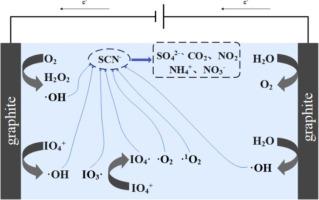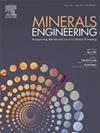Cyanide has been widely used in gold extraction due to its cost-effectiveness, high selectivity and recovery. Regrettably, its wide application also leads to the presence of a large amount of thiocyanogen (SCN
−) in the tail liquid of mineral processing plants, which affects the quality of the effluent water, and thus poses a threat to the ecological environment and human health. This paper investigates the degradation of high concentration of SCN
− in water using electrochemical oxidation/periodate (E-GP/PI) system. A degradation rate of 90.25 % of SCN
− was achieved by optimising various operating parameters. The effects of organic matter and typical heavy metal ion concentrations on the degradation of SCN
− were investigated, and it was found that Cu
2+ was able to promote the degradation of SCN
− through the formation of stable complexes with SCN
−, which enhanced the degradation rate to 96.48 %. However, the presence of Octadecyltrimethylammonium bromide (OTAB) and butylxanthin hindered the degradation process, where 500 mg/L of OTAB reduced the degradation rate of SCN
− to 80.88 %, while 100 mg/L of butylxanthin reduced the degradation rate to 78.66 %. On this basis, experiments were carried out using real wastewater samples and SCN
− degradation efficiencies of about 90 % were obtained. Afterwards, through electron paramagnetic resonance analysis, free radical burst, ion chromatograph and other research techniques, IO
3![]()
and
![]()
O
2– were obtained as the main drivers of SCN
− degradation and SCN
− degradation pathways were elucidated. Finally, the E-GP/PI system was shown to be effective in reducing the ecotoxicity of SCN
− by increasing the 24-h LC
50 from 12.5 % to 48.5 % in a toxicity test with
daphnia. This study provides a new idea for the green and efficient treatment of SCN
− rich beneficiation tail liquid.



